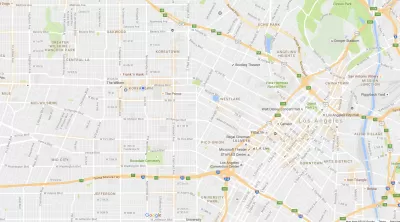Google's new maps redesign calls out areas of interest, but is "interesting" just a euphemism for rich?

"Interesting" is one of those garbage words that doesn't mean much; in different contexts, it's used to mean good, bad, weird, and (once in a great while) worthy of interest. So it was "interesting" when Google launched a new feature highlighting "areas of interest."
The deeply subjective notion of what is interesting seemed problematic (another deeply flawed word) to Joe Cortright. He cites a CityLab piece by Laura Bliss that compared the highlights in the more commercial Westlake neighborhood of Los Angeles to the richer but more residential Sawtelle, finding that Sawtelle seemed to be generously marked as "of interest" even on blocks where the only interesting things would seem to be people's houses.
Still, the word is slippery and Cortright's article in City Observatory goes on to say, "it’s a fair point to suggest that not everyone will find the same set of destinations “interesting,” and it’s likely, given capitalism, demographics and math, that any algorithm-based means of identifying interesting areas will tend to select places that appeal to the masses." Cortright suggests the solution to the "interesting” problem will come from more iteration on the concept of mapping points-of-interest, and he predicts that is likely to happen. "The more data (including everything geolocated on the web, including Google maps and listings, tweets, user reviews, and traffic data) are widely available to end users, and the more different the people who are crafting their own maps, the better we may be able to create images that reflect the diversity of interests of map users."
FULL STORY: The most interesting neighborhood in the world

Alabama: Trump Terminates Settlements for Black Communities Harmed By Raw Sewage
Trump deemed the landmark civil rights agreement “illegal DEI and environmental justice policy.”

Planetizen Federal Action Tracker
A weekly monitor of how Trump’s orders and actions are impacting planners and planning in America.

Why Should We Subsidize Public Transportation?
Many public transit agencies face financial stress due to rising costs, declining fare revenue, and declining subsidies. Transit advocates must provide a strong business case for increasing public transit funding.

Understanding Road Diets
An explainer from Momentum highlights the advantages of reducing vehicle lanes in favor of more bike, transit, and pedestrian infrastructure.

New California Law Regulates Warehouse Pollution
A new law tightens building and emissions regulations for large distribution warehouses to mitigate air pollution and traffic in surrounding communities.

Phoenix Announces Opening Date for Light Rail Extension
The South Central extension will connect South Phoenix to downtown and other major hubs starting on June 7.
Urban Design for Planners 1: Software Tools
This six-course series explores essential urban design concepts using open source software and equips planners with the tools they need to participate fully in the urban design process.
Planning for Universal Design
Learn the tools for implementing Universal Design in planning regulations.
Caltrans
Smith Gee Studio
Institute for Housing and Urban Development Studies (IHS)
City of Grandview
Harvard GSD Executive Education
Toledo-Lucas County Plan Commissions
Salt Lake City
NYU Wagner Graduate School of Public Service





























